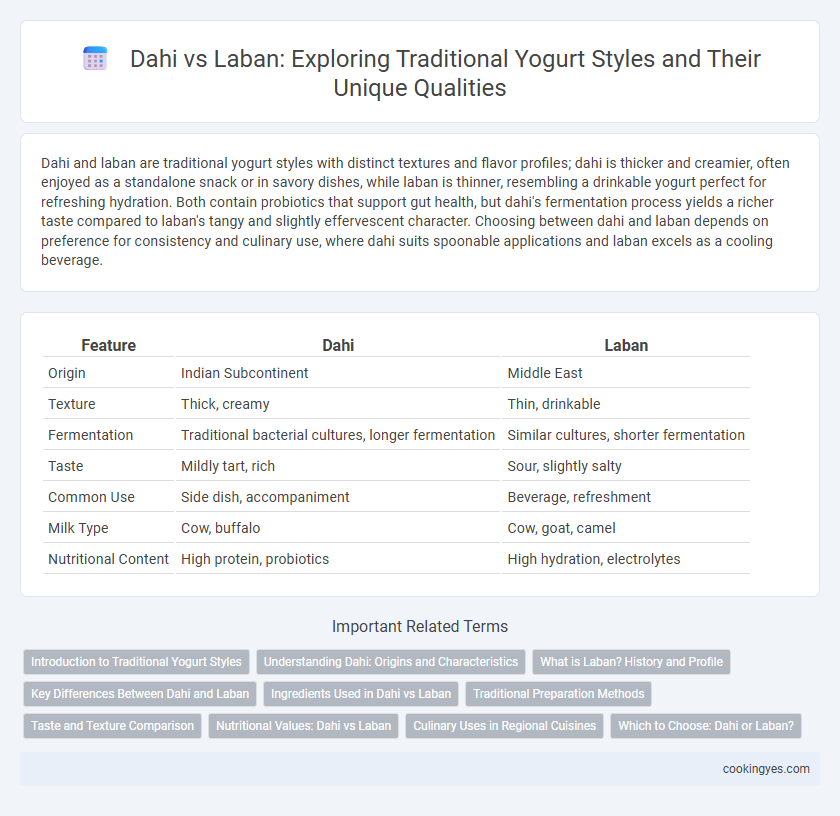Dahi and laban are traditional yogurt styles with distinct textures and flavor profiles; dahi is thicker and creamier, often enjoyed as a standalone snack or in savory dishes, while laban is thinner, resembling a drinkable yogurt perfect for refreshing hydration. Both contain probiotics that support gut health, but dahi's fermentation process yields a richer taste compared to laban's tangy and slightly effervescent character. Choosing between dahi and laban depends on preference for consistency and culinary use, where dahi suits spoonable applications and laban excels as a cooling beverage.
Table of Comparison
| Feature | Dahi | Laban |
|---|---|---|
| Origin | Indian Subcontinent | Middle East |
| Texture | Thick, creamy | Thin, drinkable |
| Fermentation | Traditional bacterial cultures, longer fermentation | Similar cultures, shorter fermentation |
| Taste | Mildly tart, rich | Sour, slightly salty |
| Common Use | Side dish, accompaniment | Beverage, refreshment |
| Milk Type | Cow, buffalo | Cow, goat, camel |
| Nutritional Content | High protein, probiotics | High hydration, electrolytes |
Introduction to Traditional Yogurt Styles
Dahi and laban represent two prominent traditional yogurt styles, each deeply rooted in South Asian and Middle Eastern culinary cultures. Dahi is typically thicker with a tangy flavor, prized for its creamy texture and probiotic benefits, while laban is a thinner, drinkable yogurt known for its refreshing and cooling properties. Both yogurts serve as staple probiotic-rich foods, contributing to gut health and digestive balance in their respective regions.
Understanding Dahi: Origins and Characteristics
Dahi, a traditional Indian yogurt, originates from the Indian subcontinent and is made by fermenting milk with a specific bacterial culture that thrives in warm climates. It has a thick, creamy texture and a subtle tangy flavor, distinguishing it from laban, a Middle Eastern yogurt drink that is thinner and more liquid. Understanding dahi's natural fermentation process highlights its probiotic benefits and cultural significance in Indian cuisine.
What is Laban? History and Profile
Laban is a traditional Middle Eastern fermented milk product, similar to yogurt but thinner in consistency and made using specific Lactobacillus strains that give it a tangy, refreshing flavor. Its history dates back thousands of years as a staple in Arab cultures, prized for its probiotic benefits and use in both cooking and as a cooling beverage. Unlike dahi, which is typically thicker and made from cow or buffalo milk with indigenous cultures, laban's fermentation process and microbial profile create a distinct texture and taste profile.
Key Differences Between Dahi and Laban
Dahi, a traditional Indian yogurt, is thicker and sourer due to its fermentation with specific lactic acid bacteria, while Laban, common in Middle Eastern cuisine, is thinner and milder with a slightly salty taste. Dahi's creamy consistency makes it ideal for raita and desserts, whereas Laban's liquid texture suits beverages and savory dishes. Both offer probiotic benefits but differ significantly in texture, flavor, and culinary uses.
Ingredients Used in Dahi vs Laban
Dahi is traditionally made by fermenting whole milk with naturally occurring lactic acid bacteria, resulting in a thick and creamy texture without added ingredients. Laban typically involves fermenting milk using specific bacterial cultures and often includes added salt, giving it a tangy and slightly savory flavor profile. Both rely on the fermentation of milk, but the inclusion of salt in laban distinguishes its taste and texture from the plain, rich consistency of dahi.
Traditional Preparation Methods
Dahi is traditionally prepared by fermenting boiled and cooled milk with a small quantity of existing yogurt as a starter, allowing natural bacterial cultures like Lactobacillus bulgaricus and Streptococcus thermophilus to develop. Laban, common in Middle Eastern cuisine, is made by incubating milk with specific probiotic strains, often involving a longer fermentation period that results in a thinner consistency. Both methods emphasize natural fermentation but differ in texture and microbial culture specificity, reflecting regional preferences in traditional yogurt styles.
Taste and Texture Comparison
Dahi offers a rich, creamy texture with a subtly tangy taste that reflects traditional Indian yogurt styles, while laban features a thinner consistency and a more pronounced sourness typical of Middle Eastern fermented milk. The thicker body of dahi allows for a smooth, velvety mouthfeel, contrasting with laban's slightly effervescent and refreshing profile. Flavor-wise, dahi's mild tartness enhances dishes with a gentle fermentation depth, whereas laban delivers a sharper, more acidic kick favored in savory recipes and beverages.
Nutritional Values: Dahi vs Laban
Dahi contains a higher concentration of probiotic cultures compared to laban, promoting improved gut health and digestion. Laban is typically richer in calcium and protein, making it a beneficial option for bone strength and muscle repair. While dahi offers a creamier texture with more natural fats, laban is often lower in fat, appealing to those seeking a lighter dairy option.
Culinary Uses in Regional Cuisines
Dahi, a traditional Indian yogurt, is creamy and thick, making it ideal for marinades, raitas, and cooling side dishes in South Asian cuisine. Laban, prevalent in Middle Eastern cooking, is tangier and often consumed as a refreshing drink or used in cold soups and salad dressings. Both yogurts enhance dishes with unique textures and flavors, reflecting their distinct regional culinary traditions.
Which to Choose: Dahi or Laban?
Dahi and laban represent two traditional yogurt styles with distinct fermentation processes and textures, influencing their culinary use and health benefits. Dahi, a thick Indian-style yogurt, is typically made by fermenting boiled milk with a starter culture of live bacteria, offering a rich, creamy texture and a tangy flavor suited for both savory and sweet dishes. Laban, a Middle Eastern fermented milk drink, is thinner and more liquid, prized for its probiotic properties and refreshing qualities, making it ideal for hydration and digestive health.
Dahi vs laban for traditional yogurt styles Infographic

 cookingyes.com
cookingyes.com